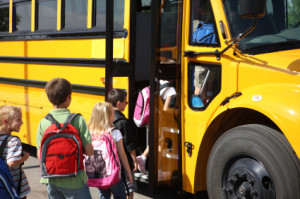 The big yellow school bus is such a cheerful sight, it’s hard to imagine that it can be a one-way trip to Bully Town. But with just one adult in charge (a driver with her hands full holding the steering wheel), that’s exactly what it can be.
The big yellow school bus is such a cheerful sight, it’s hard to imagine that it can be a one-way trip to Bully Town. But with just one adult in charge (a driver with her hands full holding the steering wheel), that’s exactly what it can be.
Maybe the target is the bus driver himself, with kids acting up to create the ultimate distracted driving nightmare. More frequently, it’s a kid-on-kid attack. As Ceri Marsh writes in Today’s Parent, when kids make all the rules, things get ugly.
Marsh tells of a 9 yr-old girl who stood her ground (seat) when an older boy on the bus tried to take her possessions. He even threatened physical violence. The bully backed off when she stood up to him, only to start hassling less assertive kids on a regular basis. Even though the school and the bully’s parents knew about the problem, he wasn’t removed from the bus for two years. Imagine sitting on that bus in a rules-free-zone for two years.
School boards tight for funding sometimes use parent volunteers or even children as onboard lifeguards. This can backfire if the bus monitor has not been properly trained to know when and how to intervene (Note: parent volunteers and students should be trained differently, reflecting their differing skills and responsibilities). There can also be a problem if the bus monitor abuses her own power, or if bullies don’t respect her authority. In our opinion, on today’s buses, with the often-present possibility of danger or violence, children should not be placed in the monitor role. We want adults on the bus, firmly in charge of discipline, until kids have internalized the rules.
Without adult intervention, the school bus can become a fight club. Si’Mone Small, in 7th grade, was beaten up on a Jacksonville, FL, bus by group of bigger boys. The adult bus driver did nothing, claiming that he “could have gotten in trouble for touching a kid.” This wasn’t a case of sexual touching or physical punishment. The bus driver should have acted to save a kid who was in trouble and needed help.
A courageous girl on the bus stopped the attack. She stepped between Si’Mone and the main instigator, a much bigger boy, and demanded that the beating stop! Caught on video! Kudos to her!
Too bad no one did that for Jamie Hubley, when kids on his school bus in Ottawa held him down and stuffed batteries down his throat. Four years of bullying ensued, in and out of school, both face-to-face and online. At age 15, Jamie committed suicide.
Bullying has to be stopped in its tracks everywhere – including on the bus – before it spreads. If the school is aware that there’s a problem with a group of kids during the school day, it’s highly likely the problem will follow them onto the bus. The bus driver and monitor should be alerted to keep “eyes on” these kids.
PREVNet, a bullying prevention and research organization, says bus drivers can and should intervene at the first signs of bullying, and report incidents to schools. The rear view mirror signs include:
- A kid tripping or being slapped in the aisle
- One kid moving another child to a different seat
- Frequent seat changing
- A child who is suddenly sad and/or quiet
- A child with missing possessions
PREVNet recommends bus drivers get off to a good start by introducing themselves to their passengers and modeling positive and respectful behavior. That way kids will feel safer reporting problems.
All parents can’t ride on the school bus with their kids, nor should they have to. The job of adults (parents, teachers, coaches, etc) is to create the rules for acceptable bus behavior and to teach kids where the limits are. Kids must know that adults will be watching and will intervene (gently, but firmly) when the line gets crossed. Kids need to know this before they ever get on the bus. Schools can help by sending home a handout on “Safe & Responsible Bus Behavior.”
There are also some simple things parents and kids can do to reduce the odds of being targeted. Ceri Marsh and Sherri Gordon suggest:
- Tell younger kids to sit near the driver and with other kids. That way they’re doubly protected, both by physical proximity to the driver and as part of a group, making it harder for a bully to isolate one kid. Sit where the driver can see you in the mirror.
- Pair your child with a bus buddy, perhaps a neighbor. That way your child will almost always have a seat companion and he’ll know who to look for on the bus.
- Encourage students to be responsible upstanders. It always comes back to respect – respect the bus driver, other kids, and the monitor. If you witness bullying on the bus (or elsewhere), take action. Make it clear it’s not okay and call on adults – the bus driver, the monitor, and the school – for help.
Hopefully we’ve got your wheels turning now on ways to make the school bus ride safe!
Learn More:
L Blumen, Bullying Epidemic: Not Just Child’s Play, Camberley Press, 2010
S Gordon, “How To Make School Buses Bully-Proof,” About.com, 2013
C Marsh, “What To Do About School-Bus Bullying,” TodaysParent.com, Aug. 28, 2013
G Tuckman, “Caught On Tape,” Anderson Cooper 360, CNN, May 20, 2005
“What School Bus Drivers Need To Know,” PREVNet.ca, 2013

